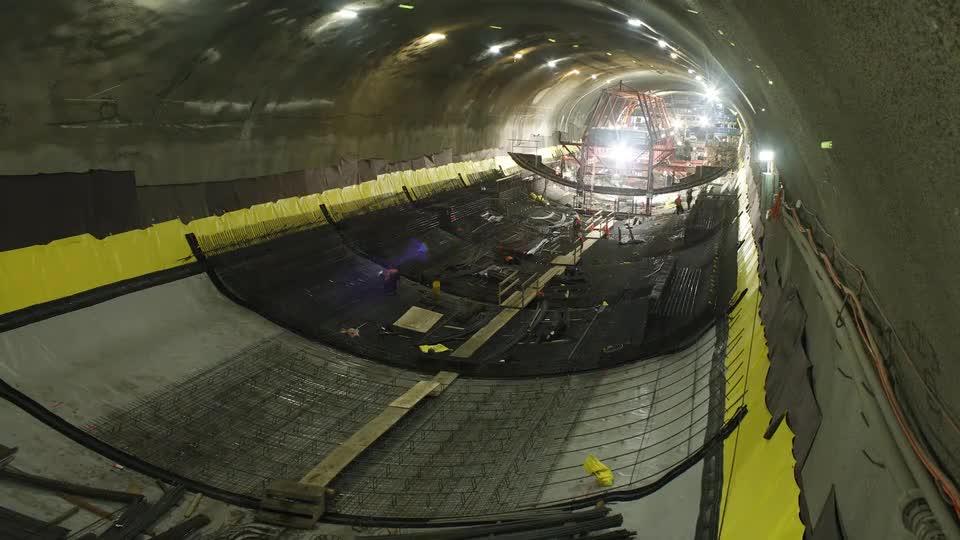Features Archive
Archive of features from the global tunnels industryFeatures By Date
March 2024
Top
Arnold Dix – Interview
A tunneller with 100 million website hits? Unlikely, surely, but Arnold Dix is an unlikely tunneller. A tunneller is not supposed to be a successful barrister, a national icon, or be world famous. Dix has, accidentally, become the exception. He is, as well as all that, the current President of the International Tunnelling and Underground Space Association (ITA-AITES); this April he is to chair ITA’s annual Member Nations General Assembly meeting at the World Tunnel Congress (WTC 2024) in Shenzhen, China. Julian Champkin spoke to him
Embrace challenges as catalysts for change
Hagerbach Test Gallery recently helped to host some of the high-level discussions of the World Systemic Forum, a key theme of which was the value of underground environments, with ITACUS taking part. Antonia Cornaro, Co-Chair of ITACUS, and also Expert Underground Space with Amberg Engineering and lecturer on Planning of Underground Space at ETH Zurich, explains how such strategic discussions help collaboration for sustainable urban development and resilience planning
Shenzhen - Zhongshan Mega Sea Link
The Shen-Zhong fixed sea link is one of China’s most pivotal and challenging infrastructure undertakings, requiring a innovation in both the design and construction realms – including for the Steel-Concrete-Steel (SCS) composite structure of the long and wide immersed tube tunnel. The project is described by CHEN Weile, SONG Shengyou, LIU Jian, CHEN Yue, and JIN Wenliang of Shen-Zhong Link Management Center
ITA on immersed & floating tunnels
Two of the many reports from ITA in the last two years have focused on immersed tunnels and floating tunnels, respectively, through the efforts of the expert team in the area, Working Group 11 (WG11)
Innovation for major segmental tunnels
Bekaert’s Dramix® fibres have recently played significant roles for tunnel projects in two countries with major events coming soon – in France, where the Grand Paris Express subway is supporting the capital hosting the 2024 Summer Olympic Games, and in China, which will shortly host the World Tunnel Congress (WTC) 2024 and among its many large projects to be featured is Qingdao Second Road Tunnel at Jiaozhou Bay. The designs are discussed by Benoit de Rivaz, Global Technical Manager, Bekaert BP Underground Solutions
Many requirements in Sweden – one MTBM hard rock solution
An exceptional microtunnelling project in Edsberg, Sweden, posed particularly complex challenges: very hard, highly abrasive rock and no possibility of a target shaft. The solution was the newly developed AVN 800 HR from Herrenknecht in combination with jacking of a temporary steel pipe string to withdraw the MTBM. Herrenknecht’s Michael Groß, Senior Product Manager Pipe Jacking, and Lutz zur Linde, Sales Manager Utility Tunnelling, discuss the technology and its application
Hypertunnel – Evolution Of Testing
R&D for hyperTunnel’s robots has evolved using ‘swarm’ rather than classic individual testing to enable the system to work in underground construction environments. The approach is discussed by Conor West, Support and Service Engineer with the company
February 2024
Top
Robert Mair – Interview
Few in the tunnelling world are known to the general public, fewer still are profiled in a broadcast programme such as on BBC’s prestigious ‘The Life Scientific’ on Radio Four. In fact, only one has been accorded that mark of public recognition and interest – Robert Mair, Emeritus Professor of Civil Engineering at Cambridge University, and recent Master of Jesus College there, and is past-President of the Institution of Civil Engineers.
Resilient underground design and systems
The need for subsurface spaces to be more sustainable and resilient was the focus of an ITA report published last year which, in considering ‘Urban Underground Space for Resilient Cities’, looked at need, strategies, design concepts to address the challenges
Delving Deep: Rethinking Underground Use
Rethinking Our Cities using the Underground Space’ was the important theme of a dedicated collaborative event hosted in Porto, Portugal, by the Portuguese tunnelling society (CPT), in Nov 2023, and moderated by ITACUS Co-chair Antonia Cornaro, Expert Underground Space with Amberg Engineering as well as lecturer on Planning of Underground Space at ETH Zurich. In this article, she describes and summarises the key points of the interesting discussion.
Technological Innovation Drives The High-Quality Development Of The Shenzhen Metro
Under the guidance of the innovation-driven development strategy, Shenzhen Metro is undergoing a transformation in its development model, transitioning from rapid expansion to a focus on highquality development.
Norwegian tunnels stats update: 2023
Latest annual data update on tunnelling activity in Norway shows another year of higher activity overall and another year of changes in who is most active
Validity of The NTNU Prediction Model for D&B Tunnelling
A number of predictive models for tunnelling works were established some decades ago by Norwegian researchers and continuously improved to better fit modern trends. This paper examines one such model, for Drill & Blast, against a range of recent project data from across the country. The findings demonstrate that while the empirical methodology is still highly relevant some further improvements, and additional empirical relations, are suggested to accommodate 16 years of development in technology, equipment, contractual issues and blast design
January 2024
Top
Low carbon backfill grout
Sika is launching a new reduced carbon backfill grout for TBMs, called Sika® Stabilizer-7100 TBM. Mike A. Sposetti, Global Technical Manager (TBM), Underground Construction with Sika Group AG explains the background and provide details
Focus on active management
Three themes among many at the 10th International Symposium of Tunnel Safety and Security (ISTSS), held in Norway last April, were focused on active management – of Safety, Emergency and Evacuation in underground transport. But while themes exist as do disciplines and specialisms, there was also a message of whole systems thinking – to appreciate and work with lies beyond your own discipline for the greater, safer, good
Salisbury crash report
The findings of a study into the train collisions that left carriages jammed inside a tunnel portal near Salisbury in England, in 2021, have been published by the UK’s Rail Accident Investigation Branch (RAIB).
Making Headway on Nepal Headrace
The Robbins double-shield TBM is making good progress despite tough geology and challenges in the Himalayas on the headrace tunnel for the Sunkoshi Marin multi-purpose project, in Nepal.
Driving slurry rock tunnelling in small diameters
A discussion on the latest trends and technologies for small-diameter slurry mechanised tunnelling in rock. This article is based on two papers by Herrenknecht engineers – ‘Rock tunnelling in small diameter: latest trends and technologies’9, and ‘Slurry pipe jacking in hard rock: Pushing boundaries for sustainable infrastructure’
Advancing with shields in India
Terratec machines are busy in India, including successfully advancing on the metro project in Chennai and on Mithi River water quality improvement project in Mumbai
Data focus on rail & metro tunnels
Courtesy of GlobalData, a sister publication of T&T, we take a look at tunnel-based infrastructure project spend which is dominated by the transport sector, itself led in activity by rail & metro, based on figures from the Q3-2023 analysis




